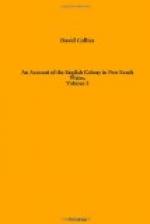[* How much superior in contrivance to those about Port Jackson, or in Van Diemen’s Island!]
The meridional altitude of the sun gave 29 degrees 26 minutes 28 seconds S for the latitude of the entrance into the bay.
Many white cockatoos and paroquets were seen about here, and a crow whose note was remarkably short and hasty. Numbers of pelicans, with some gulls and red bills, frequented the shoals, and the country itself was very sandy wherever they landed. The palm nut-tree which grows here was the third kind of palm mentioned by Captain Cook as being produced on the eastern coast of New South Wales.* This, he says, was found only in the northern parts; and as Bong-ree, who was tolerably well acquainted with the country as far as Port Stephens, never saw or heard of it before, this was probably one of the most southern situations in which it would be found.
[* Vide Hawkesworth’s Voyages, Vol III p 624.]
The individual nuts were seen scattered about the fire-places of the natives; and it was observed, that the lower end of them had been chewed and sucked in the manner that artichokes are eaten. This method, on procuring some that were ripe, was afterwards practised.
The taste was rather pleasant at first, but left an astringency behind that scarcely tempted one to try a second time. The eatable part of the nut in this way was so small, as to be not worth the trouble of sucking it out from the fibres. They were about the size of a walnut; within the outer skin was a hard shell like that of the cocoa nut; and within this, two, or perhaps more, almond-like kernels. The nut, as taken from the tree, was an assemblage of these kernels set into a cone, and was from the size of a man’s two fists, to that of his head. Its size, and the furrows or indentations upon the surface, appeared on the first view like the exterior form of the bread fruit, but a pine apple may be a better object of comparison. The stem of the tree was short, and none were observed to be two feet or even eighteen inches in diameter. The branches did not ramify into twigs, but preserved their size to the extreme, where the leaves were produced surrounding the fruit. One or two smaller branches here and there struck off from the main branch, and produced their leaves in the same way, without fruit. The height of the tree all together might be from fifteen to twenty-five or thirty feet. Suckers or branches of all sizes were seen shooting out below those bearing fruit, and, growing downwards along the stem, entered the ground, where they not only formed roots, but became supporters to the tree.




